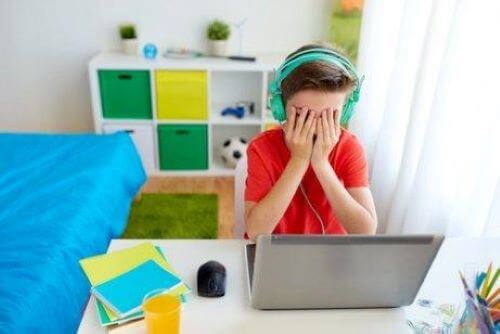Legal Aspects of Cyberbullying at School

Cyberbullying at school is an unfortunate reality that many boys and girls experience today. It’s also a form of violence that is increasing.
Cyberbullying has very negative effects on the wellbeing and development of children and adolescents. In addition, it goes against the fundamental rights of the victim. It can cause great emotional and psychological damage to the victims and their families.
Unfortunately, public officials still don’t do enough to address cyberbullying at school, nor is it recognized in all its gravity by the corresponding institutions.
This issue affects many factors, including psychological, educational, familiar, and the media… Below we’ll take a look at some of the legal aspects of cyberbullying at school.
What is cyberbullying at school?
Cyberbullying at school is a form of harassment. It’s a form of violent and negative interaction that happens among peers, but in the social media context. It has to do with social relations at school. The kinds of violence associated with school cyberbullying are discrimination, homophobia, and repression, among others.
Cyberbullying is a kind of psychological persecution that one student inflicts on another. The harasser chooses the victim and carries out repeated attacks. It’s a negative and intended action that the victim cannot avoid in the school environment or address on his or her own.
To consider an example of aggression as a case of bullying, there has to be a situation of inequality between the harasser and the victim. That inequality can be physical, psychological, or social.
There is also a clear intention to do harm. Bullying is generally a form of aggression that is continued or repeated in nature.
Differences between bullying and cyberbullying
It’s true that cyberbullying shares a lot of the same characteristics with regular bullying at school. Nonetheless, cyberbullying is unique because the aggressors use new technologies to humiliate, intimidate, harass, and threaten their victims. The main mediums are social media, SMS, email, and blogs…

The damage caused by this type of bullying is also different. With cyberbullying, there is an invasion of privacy. This occurs, principally, by the diffusion of videos and compromising photos without the victim’s consent.
Another characteristic of this kind of bullying is that the impact is more widespread and public. The number of people who see the compromising photos or information is much higher than in traditional bullying at school.
In addition, cyberbullying has a farther reach in that its impacts are also felt outside of school. It follows the victim in every moment and it’s shared everywhere.
From the legal standpoint, both bullying at school and cyberbullying constitute a fundamental violation of the rights of minors. These two types of violence cause enormous psychological damage to the victims and their families.
On occasion, the consequences have been fatal. Bullying has led to the suicide of young victims. Nonetheless, despite the gravity of the situation, in Spain, for example, the Penal Code doesn’t recognize either bullying or cyberbullying.
The Penal Code doesn’t recognize school bullying
When giving out penal sentences for cases of school bullying or cyberbullying, the Penal Code obligates Judges and Tribunals to apply only the existing penalties in the Penal Code.
These loopholes exist because the Penal Code doesn’t have a penalty defined for cases of bullying. Depending on the situation and the intensity of the bullying, we can find ourselves effectively facing various types of crimes.
In extreme cases, like when the school cyberbullying ends in the suicide of the victim, the type of penalty that can be applied is the “crime of homicide or murder” or the “crime of induction to suicide.”
Threats and coercion are very common in cases of cyberbullying at school. In these cases, you could apply the “crime of threats and coercion” or the “crime of bullying or harassment.” The “crime against moral integrity” is also applicable in many cases.

In the case where there’s the use of photos or intimate videos of the victim, that the aggressor has shared without their consent, the following laws can be applied:
- “Crime against the intimacy of a minor.”
- “Crime of possession of child pornography”
- The majority of cyberbullying cases also involve the “crime of libel or slander.”
If you suspect your children are victims of a harmful case of cyberbullying at school, you should seek legal advice. It may take a lot of patience and resolve but there’s a need to see more of these cases when they occur so there’s more pressure to change the laws accordingly.
Hopefully, this will help to more effectively deter cyberbullying in the future.
Cyberbullying at school is an unfortunate reality that many boys and girls experience today. It’s also a form of violence that is increasing.
Cyberbullying has very negative effects on the wellbeing and development of children and adolescents. In addition, it goes against the fundamental rights of the victim. It can cause great emotional and psychological damage to the victims and their families.
Unfortunately, public officials still don’t do enough to address cyberbullying at school, nor is it recognized in all its gravity by the corresponding institutions.
This issue affects many factors, including psychological, educational, familiar, and the media… Below we’ll take a look at some of the legal aspects of cyberbullying at school.
What is cyberbullying at school?
Cyberbullying at school is a form of harassment. It’s a form of violent and negative interaction that happens among peers, but in the social media context. It has to do with social relations at school. The kinds of violence associated with school cyberbullying are discrimination, homophobia, and repression, among others.
Cyberbullying is a kind of psychological persecution that one student inflicts on another. The harasser chooses the victim and carries out repeated attacks. It’s a negative and intended action that the victim cannot avoid in the school environment or address on his or her own.
To consider an example of aggression as a case of bullying, there has to be a situation of inequality between the harasser and the victim. That inequality can be physical, psychological, or social.
There is also a clear intention to do harm. Bullying is generally a form of aggression that is continued or repeated in nature.
Differences between bullying and cyberbullying
It’s true that cyberbullying shares a lot of the same characteristics with regular bullying at school. Nonetheless, cyberbullying is unique because the aggressors use new technologies to humiliate, intimidate, harass, and threaten their victims. The main mediums are social media, SMS, email, and blogs…

The damage caused by this type of bullying is also different. With cyberbullying, there is an invasion of privacy. This occurs, principally, by the diffusion of videos and compromising photos without the victim’s consent.
Another characteristic of this kind of bullying is that the impact is more widespread and public. The number of people who see the compromising photos or information is much higher than in traditional bullying at school.
In addition, cyberbullying has a farther reach in that its impacts are also felt outside of school. It follows the victim in every moment and it’s shared everywhere.
From the legal standpoint, both bullying at school and cyberbullying constitute a fundamental violation of the rights of minors. These two types of violence cause enormous psychological damage to the victims and their families.
On occasion, the consequences have been fatal. Bullying has led to the suicide of young victims. Nonetheless, despite the gravity of the situation, in Spain, for example, the Penal Code doesn’t recognize either bullying or cyberbullying.
The Penal Code doesn’t recognize school bullying
When giving out penal sentences for cases of school bullying or cyberbullying, the Penal Code obligates Judges and Tribunals to apply only the existing penalties in the Penal Code.
These loopholes exist because the Penal Code doesn’t have a penalty defined for cases of bullying. Depending on the situation and the intensity of the bullying, we can find ourselves effectively facing various types of crimes.
In extreme cases, like when the school cyberbullying ends in the suicide of the victim, the type of penalty that can be applied is the “crime of homicide or murder” or the “crime of induction to suicide.”
Threats and coercion are very common in cases of cyberbullying at school. In these cases, you could apply the “crime of threats and coercion” or the “crime of bullying or harassment.” The “crime against moral integrity” is also applicable in many cases.

In the case where there’s the use of photos or intimate videos of the victim, that the aggressor has shared without their consent, the following laws can be applied:
- “Crime against the intimacy of a minor.”
- “Crime of possession of child pornography”
- The majority of cyberbullying cases also involve the “crime of libel or slander.”
If you suspect your children are victims of a harmful case of cyberbullying at school, you should seek legal advice. It may take a lot of patience and resolve but there’s a need to see more of these cases when they occur so there’s more pressure to change the laws accordingly.
Hopefully, this will help to more effectively deter cyberbullying in the future.
All cited sources were thoroughly reviewed by our team to ensure their quality, reliability, currency, and validity. The bibliography of this article was considered reliable and of academic or scientific accuracy.
- UNICEF. Ciberacoso. Extraído de: http://www.aeped.es/sites/default/files/documentos/entrega4_aep_ciberacoso.pdf
- adolescenciasema.org. Guía sobre el ciberacoso. Extraído de: https://www.adolescenciasema.org/usuario/documentos/Guia_Ciberacoso_Profesionales_Salud_FBlanco.pdf
- Armero Pedreira, P., Bernardino Cuesta, B., & Bonet de Luna, C. (2011). Acoso escolar. Pediatria de Atencion Primaria. https://doi.org/10.4321/S1139-76322011000600016
- Enríquez Villota, M. F. (2018). El acoso escolar. Saber, Ciencia y Libertad. https://doi.org/10.18041/2382-3240/saber.2015v10n1.983
- Felix Mateo Vicente, Soriano Ferrer Manuel, Godoy Mesas Carmen, & Sancho Vicente Sonia. (2010). El ciberacoso en la enseñanza obligatoria. Aula Abierta.
- Olweus, D. (1993). Acoso escolar,“bullying”, en las escuelas: hechos e intervenciones. Centro de investigación para la Promoción de la Salud, Universidad de Bergen, Noruega, 2. https://www.researchgate.net/profile/Dan_Olweus/publication/253157856_ACOSO_ESCOLARBULLYING_EN_LAS_ESCUELAS_HECHOS_E_INTERVENCIONES/links/0f31753c7d61c06b1c000000.pdf
- Suckling, A. (2006). Herramientas contra el acoso escolar: un enfoque integral. Ediciones Morata.
This text is provided for informational purposes only and does not replace consultation with a professional. If in doubt, consult your specialist.








